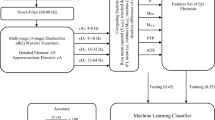Abstract
Brain computer interface (BCI) aims at creating new communication channels without depending on brain’s normal output channels of peripheral nerves and muscles. However, natural and sophisticated interactions manner between brain and computer still remain challenging. In this paper, we investigate how the duration of event-related desynchronization/synchronization (ERD/ERS) caused by motor imagery (MI) can be modulated and used as an additional control parameter beyond simple binary decisions. Furthermore, using the non-time-locked properties of sustained (de)synchronization, we have developed an asynchronous BCI system for driving a car in 3D virtual reality environment (VRE) based on cumulative incremental control strategy. The extensive real time experiments confirmed that our new approach is able to drive smoothly a virtual car within challenging VRE only by the MI tasks without involving any muscular activities.
Similar content being viewed by others
References
Nicolelis M A L. Actions from thoughts. Nature, 2001, 409(6818): 403–407
Wolpaw J R, Birbaumer N, McFarland D J, et al. Brain-computer interfaces for communication and control. Clin Neurophysiol, 2002, 113(6): 767–791
Dornhege G. Toward Brain-Computer Interfacing. Cambridge, MA: MIT Press, 2007
Serruya M, Hatsopoulos N, Paninski L, et al. Instant neural control of a movement signal. Nature, 2002, 416(6877): 141–2
Wessberg J, Stambaugh C R, Kralik J D, et al. Real-time prediction of hand trajectory by ensembles of cortical neurons in primates. Nature, 2000, 408(6810): 361–365
Taylor D M, Tillery S I H, Schwartz A B. Direct cortical control of 3D neuroprosthetic devices. Science, 2002, 296(5574): 1829
Musallam S, Corneil B D, Greger B, et al. Cognitive control signals for neural prosthetics. Science, 2004, 305(5681): 258–262
Santhanam G, Ryu S I, Yu B M, et al. A high-performance braincomputer interface. Nature, 2006, 442(7099): 195–198
Chapin J K, Moxon K A, Markowitz R S, et al. Real-time control of a robot arm using simultaneously recorded neurons in the motor cortex. Nat Neurosci, 1999, 2: 664–670
Müller K R, Blankertz B. Toward noninvasive brain-computer interfaces.IEEE Signal Processing Magazine, 2006, 23(5): 125–128
Pfurtscheller G, Brunner C, Schlögl A, et al. Mu rhythm (de) synchronization and EEG single-trial classification of different motor imagery tasks. NeuroImage, 2006, 31(1): 153–159
Blankertz B, Dornhege G, Krauledat M, et al. The non-invasive berlin brain-computer interface: Fast acquisition of effective performance in untrained subjects. NeuroImage, 2007, 37(2): 539–550
Blankertz B, Tomioka R, Lemm S, et al. Optimizing spatial filters for robust EEG single-trial analysis. Signal Processing Magazine, 2008, IEEE, 25(1): 41–56
Sitaram R, Zhang H, Guan C, et al. Temporal classification of multichannel near-infrared spectroscopy signals of motor imagery for developing a brain-Computer interface. NeuroImage, 2007, 34(4): 1416–1427
Birbaumer N, Ghanayim N, Hinterberger T, et al. A spelling device for the paralysed. Nature, 1999, 398(6725): 297–8
Pfurtscheller G, Neuper C, Muller G R, et al. Graz-BCI: State of the art and clinical applications. IEEE Transactions on Neural Systems and Rehabilitation Engineering, 2003, 11(2): 1–4
Wolpaw J R, McFarland D J, Bizzi E. Control of a Two-dimensional movement signal by a noninvasive brain-computer interface in humans. Proc Natl Acad Sci USA, 2004, 101(51): 17849–17854
Wolpaw J R, McFarland D J, Vaughan T M, et al. The Wadsworth center brain-computer interface (BCI) research and development program. IEEE Transactions on Neural Systems and Rehabilitation Engineering, 2003, 11(2): 1–4
Muller K R, Krauledat M, Dornhege G, et al. Machine learning techniques for brain-computer interfaces. Biomed Tech, 2004, 49(1): 11–22
Dornhege G, Blankertz B, Krauledat M, et al. Combined optimization of spatial and temporal filters for improving brain-computer interfacing. IEEE Trans Biomed Eng, 2006, 53(11): 2274–2281
Blankertz B, Dornhege G, Lemm S, et al. The berlin brain-computer interface: Machine learning based detection of user specific brain states. J Univ Comp Sci, 2006, 12(6): 581–607
Muller K R, Anderson C W, Birch G E. Linear and nonlinear methods for brain-computer interfaces. IEEE Transactions on Neural Systems and Rehabilitation Engineering, 2003, 11(2): 165–169
Kamousi B, Liu Z, He B. Classification of motor imagery tasks for brain-computer interface applications by means of two equivalent dipoles analysis. IEEE Transactions on Neural Systems and Rehabilitation Engineering, 2005, 13(2): 166–171
Pfurtscheller G, Leeb R, Keinrath C, et al. Walking from thought. Brain Res, 2006, 1071(1): 145–152
Krepki R, Blankertz B, Curio G, et al. The berlin brain-computer interface (BBCI)-towards a new communication channel for online control in gaming applications. Multimedia Tools Appl, 2007, 33(1): 73–90
Fetz E. Real-time control of a robotic arm by neuronal ensembles. Nat Neurosci, 1999, 2: 583–584
Donoghue J. Connecting cortex to machines: Recent advances in brain interfaces. Nat Neurosci, 2002, 5(suppl): 1085–1088
Pfurtscheller G, Lopes da Silva F. Event-related EEG/MEG synchronization and desynchronization: basic principles. Clin Neurophysiol, 1999, 110(11): 1842–1857
Pfurtscheller G, Neuper C, Brunner C, et al. Beta rebound after different types of motor imagery in man. Neurosci Lett, 2005, 378(3): 156–159
Ramoser H, Muller-Gerking J, Pfurtscheller G. Optimal spatial filtering of single trial EEG during imagined handmovement. IEEE Transact Neur Syst Rehabilit Eng, 2000, 8(4): 441–446
Müller-Gerking J, Pfurtscheller G, Flyvbjerg H. Designing optimal spatial filters for single-trial EEG classification in a movement task. Clin Neurophysiol, 1999, 110: 787–798
Wang Y, Zhang Z, Li Y, et al. BCI competition 2003-data set IV: An algorithm based on CSSD and FDA for classifying single-trial EEG. IEEE Transactions on Biomedical Engineering, 2004, 51(6): 1081–1086
Author information
Authors and Affiliations
Corresponding author
Additional information
Supported by the National High-Tech Research Program of China (Grant No. 2006AA01Z125) and the National Basic Research Program of China (Grant No. 2005CB724301)
About this article
Cite this article
Zhao, Q., Zhang, L. & Cichocki, A. EEG-based asynchronous BCI control of a car in 3D virtual reality environments. Chin. Sci. Bull. 54, 78–87 (2009). https://doi.org/10.1007/s11434-008-0547-3
Received:
Accepted:
Published:
Issue Date:
DOI: https://doi.org/10.1007/s11434-008-0547-3




